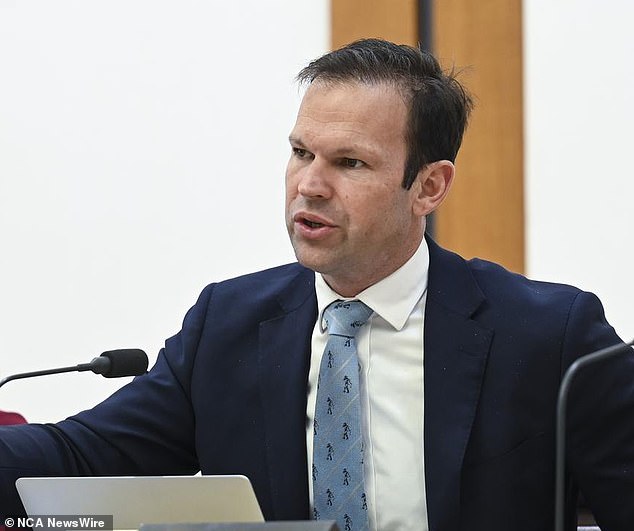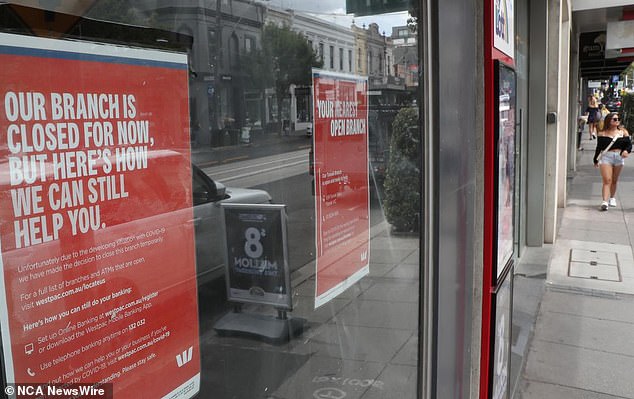The government is urged to investigate creating a publicly owned bank to ensure Australians have access to financial services as more banks go cashless and close brick-and-mortar stores.
Presenting its final report on Friday, a Senate committee investigating the effect of branch closures on consumers and businesses recommended making the current Banking Code of Conduct mandatory.
Under the code, banks would be required to conduct “meaningful” consultation with communities before closing a branch, and fund transition and ongoing services to ensure access to cash and essential banking services in the event of closure.
Hundreds of branches of the big four banks have closed across Australia in recent years and many more have run out of cash (pictured: Westpac Bank branch with a closed sign in the window)

Matt Canavan has been leading the Senate inquiry into rural branch closures.
To enforce the mandatory code, a regulator would have the authority to approve or defer any closure request, and banks would be penalized if consultation or disclosure requirements were not met.
Additionally, the committee recommended that the Australian Competition and Consumer Commission be tasked with exploring the barriers customers face when switching banks.
The government should also fund the establishment of community bank branches, the inquiry’s final report argued, and the cost of the new fund to help establish “community branches” would be supplemented by an increase in the tax on big banks.
The committee’s final report also recommended an expansion of the Bank@Post service, including forcing ANZ to register for the service.
In individual deals worth a cumulative $90 million, customers of Commonwealth Bank, Westpac and NAB, along with several smaller banks, can now access Australia Post’s 3,500 branches for simple services such as withdrawing and depositing cash at the program framework.
While ANZ has not offered its services through Bank@Post since 2019, its chief executive, Shayne Elliott, has signaled he is open to returning once its merger with Suncorp is complete.
While the committee did not recommend the immediate creation of a state bank, it did argue that a feasibility study should cover such a proposal, possibly in partnership with the existing Bank@Post model.
But Australian Banking Association (ABA) chief executive Anna Bligh warned a publicly owned bank was a treacherous proposition.
“Given the past catastrophic failures of state banks in this country, Australians should be wary of suggestions of a new taxpayer-funded state bank,” Ms Bligh said.

ABA chief Anna Bligh warned against creating a publicly owned bank
“A large government-owned bank would seriously jeopardize the current viability of many small and medium-sized banks serving customers in regional and rural Australia.”
The spectacular implosion of state banks in Victoria and South Australia in the early 1990s was among the biggest economic disasters in Australia’s recent history and ultimately led to the defeat of two Labor state governments.
Committee chairman, Queensland Nationals senator Matt Canavan, accused major banks of failing to act in good faith over branch closures in regional cities. “A tougher and more proactive approach is now needed to rebuild financial services in the bush,” Mr Canvan said.
“The big banks have been the main reason there is a financial desert in so many rural towns and so it is perfectly reasonable for them to pay a small fee to help rebuild financial services in the countryside.”
The inquiry held hearings in a number of regional centres, including Cloncurry, Tom Price and Launceston, with witnesses reporting that bank branches were an essential service in many communities, particularly for older people and those without internet access or with low financial knowledge.
Businesses with high levels of cash transactions in regional and remote areas also reported being required to travel long distances to make deposits as they did not have secure premises to hold significant cash reserves.

In recent years, cash usage in Australia has shifted towards tap-and-go, cards and electronic transfers rather than physical cash, largely due to convenience
According to data published by S&P Global Market Intelligence, Westpac closed 167 branches last year. Commonwealth Bank closed 73, ANZ closed 72, while NAB closed 72. These figures cover urban, regional and rural areas.
Data released by the ABA shows that consumers have overwhelmingly shifted toward online banking in recent years, with 98.9 percent of transactions now taking place via the Internet or banking apps.
Another 0.7 percent of transactions are carried out in physical branches, while the remaining 0.4 percent are carried out through telephone and chatbox functions.
Similarly, the increase in the share of digital wallet transactions and the corresponding decrease in cash usage has also decreased branch usage: only 12 percent of consumers reported visiting their local bank weekly.
CBA and Westpac have extended their moratoriums on branch closures until December 2026 and January 2027 respectively. ANZ has committed to suspending closures until the completion of the investigation, while NAB has continued to close regional locations.


